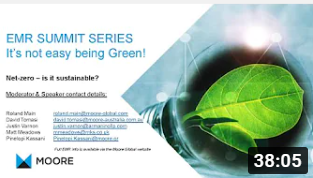By David Tomasi
Moore Global Energy, Mining & Renewables Leader
There is a serious risk that COP26 will create unrealistic expectations about what is possible on the road to net zero carbon emissions, while ignoring the real-world progress we are making towards a more sustainable economic future.
The talks in Glasgow were preceded by an awkward announcement from the United Nations Environment Programme that action plans announced by various countries will knock only 7.5% off predicted emissions in 2030 – whereas a drop of 55% is needed to limit global warming to the target of 1.5C. It does not help that India and China, which account for one-third of the world’s emissions, have set their own net zero targets which push the deadline toward the end of the century.
This was perhaps inevitable because meeting those targets is either impossible with current technology or only achievable by changing ingrained human behaviours. We have set the bar higher and higher on controlling climate change without knowing how we are going to jump over it.
One of the most important actions COP26 delegates could take is simply to acknowledge the harsh fact that it is not easy going green without risking the very fabric of modern society and the vast, interconnected global economy that has improved the lives of billions of families.
Once we accept the process of decarbonisation is difficult, we can move the debate on to practical steps to tackle the most pressing problems and agree stop-gap solutions that will reduce emissions and buy time to develop the technology needed to provide long-term answers.
The big date everyone has in their minds is 2050, by which time it is hoped that global warming will have been limited to 1.5°C.
The International Renewable Energy Agency (IRENA) has described a path towards that laudable goal in which 90% of electricity needs to come from renewable sources. Wind and solar are prominent in this scenario but there are problems here.
A quirk of nature means that wind speeds have often dropped too low to turn the windmill blades. For example, weather modelling group Vortex says northern Europe has experienced a fall in the strength of the wind of up to 15% on average in some parts this year.
Solar, the other pillar of renewable strategies, also has its issues. I live in Perth in Australia, one of the sunniest places on the planet, which seems to have solar panels on every roof top.
During our hot, bright days the sun provides cheap power for homes and industry. However, despite 15 years of trying, scientists have failed to come up with efficient batteries to store enough of that daytime energy to keep the lights on in the evening. That means we must rely on other non-renewable sources for base load power when the sun sets, which plays havoc with our electricity grid.
I am not suggesting we give up on solar and wind but we do need time and investment to figure out how to get the best from them in all conditions, 24/7.
Policy in most countries seems to be based on the discovery of some sort of ‘moonshot’ technology that, with one bound, will release us into the sunny uplands of a sustainable, net zero future. However, the advances that are portrayed as our saviour are still some time away – and may never prove viable.
We cannot wait for something that may or may not work and we should be putting as much effort into stop-gap measures we understand. They will reduce carbon emissions, although perhaps not in the timeframe COP26 delegates wish for.
Hydrogen is the most abundant element in the universe and emits no carbon when burned. For most of the past decade it has largely been written out of the picture as a potential alternative to fossil fuels because of worries about costs of production and its stability under the high pressures required to store it at.
However, it is a source of energy that would allow so many industries to reduce their need for coal and natural gas. Energy consultancy Wood Mackenzie estimates there has been a fiftyfold increase in announced green hydrogen projects in the last 12 months, primarily in the Middle East and Australia. Global demand for low-carbon hydrogen could be 530 million tonnes by 2050 – that would make a big dent in the 1.5C global warming target.
At the moment the market is dominated by ‘blue’ hydrogen made using fossil fuels. It is three times cheaper than ‘green’ hydrogen, which can be created with renewable sources. Green trumps blue in environmental terms but both will be vital on the path to net zero and it is likely green costs will come down as more investment goes into the renewable production chain.
Significant advances towards green hydrogen would be a real boon for the shipping industry. It transports 90% of the world’s freight yet, if it was a country, would be the world’s sixth largest polluter.
The production of green hydrogen is also associated with another technology which seems to be forever on the fringes of the net zero debate: carbon capture. As the name suggests, this process captures harmful emissions produced by factories and chemical plants before storing it away in vast underground reservoirs where it cannot contribute to heating Earth’s atmosphere.
Two carbon capture test sites less than 250 miles from the Glasgow COP26 summit were sanctioned recently by the UK government. Carbon capture technology is still in its infancy but imagine if it works even half as well as predicted? It will clean the air in our most heavily polluted industrial regions and generate a whole raft of new green jobs.
Nuclear is another unfashionable alternative but advances in safety and efficiency make it a real contender. The debate seems now to be about how to fund projects with a life cycle of more than half a century. The money is there, we just need to find a suitable risk-reward model. Surely, that cannot be beyond us.
Today’s nuclear plants rely on fission – splitting the atom – to create energy but the long-term answer for nuclear may lie in experiments taking place in southern France. There, the International Thermonuclear Experimental Reactor (ITER) is attempting to harness nuclear fusion, a process that recreates the immense forces and temperatures at the centre of the sun to fuse atoms together to generate limitless cheap electricity. The other big benefit: no long-term radioactive waste to worry about.
The scientists running ITER have found it difficult to pin down a definitive date for producing ‘first plasma’ – the key step in proving the nuclear fusion theory can be translated into practice – but even if it takes another ten years, that would still be an amazing scientific and engineering achievement.
Almost every company in the energy, mining and renewables sector is under scrutiny. Yes, governments hold a large stick but it is banks, fund managers and investors that are forcing companies to face up to their environmental responsibilities – and declining to fund projects that do not match their rising expectations.
Last year Reptrak, a reputation consultancy, found that of the factors that would prompt consumers to recommend a company, environmental, social and governance (ESG) practices ranked fifth highest. When things go wrong, a strong ESG track record is the third most important factor in determining whether customers will give an organisation the benefit of the doubt.
Change is happening. However, CEOs know they have to proceed with caution and test new theories thoroughly in order to reduce the chances of a misstep that could cost customers, shareholders – and the planet – dearly.
With the bar set so high on emissions targets, it is unrealistic to expect us to reach it with one giant leap. Instead, we should think of it like climbing a step ladder, each rung on the way up representing an incremental improvement that contributes to cutting emissions.
Targets should be viewed as aspirations but the real aim is to get to the top step without the base of the ladder toppling over. That is the way to achieve real and lasting change.
WATCH OUR EMR SUMMIT SERIES
|
Cyber Wake Up
|
Net Zero - Is it sustainable?
|
ESG - Delivering the caring dividend
|
 |
 |
 |